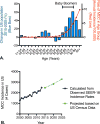Merkel cell carcinoma: Current US incidence and projected increases based on changing demographics
- PMID: 29102486
- PMCID: PMC5815902
- DOI: 10.1016/j.jaad.2017.10.028
Merkel cell carcinoma: Current US incidence and projected increases based on changing demographics
Abstract
Background: Merkel cell carcinoma (MCC) incidence rates are rising and strongly age-associated, relevant for an aging population.
Objective: Determine MCC incidence in the United States and project incident cases through the year 2025.
Methods: Registry data were obtained from the SEER-18 Database, containing 6600 MCC cases. Age- and sex-adjusted projections were generated using US census data.
Results: During 2000-2013, the number of reported solid cancer cases increased 15%, melanoma cases increased 57%, and MCC cases increased 95%. In 2013, the MCC incidence rate was 0.7 cases/100,000 person-years in the United States, corresponding to 2488 cases/year. MCC incidence increased exponentially with age, from 0.1 to 1.0 to 9.8 (per 100,000 person-years) among age groups 40-44 years, 60-64 years, and ≥85 years, respectively. Due to aging of the Baby Boomer generation, US MCC incident cases are predicted to climb to 2835 cases/year in 2020 and 3284 cases/year in 2025.
Limitations: We assumed that the age-adjusted incidence rate would stabilize, and thus, the number of incident cases we projected might be an underestimate.
Conclusion: An aging population is driving brisk increases in the number of new MCC cases in the United States. This growing impact combined with the rapidly evolving therapeutic landscape warrants expanded awareness of MCC diagnosis and management.
Keywords: MCC; Merkel cell carcinoma; epidemiology; incidence.
Copyright © 2017 American Academy of Dermatology, Inc. Published by Elsevier Inc. All rights reserved.
Figures



References
-
- Lemos B, Nghiem P. Merkel cell carcinoma: more deaths but still no pathway to blame. J Invest Dermatol. 2007;127:2100–3. - PubMed
MeSH terms
Grants and funding
LinkOut - more resources
Full Text Sources
Other Literature Sources
Medical

